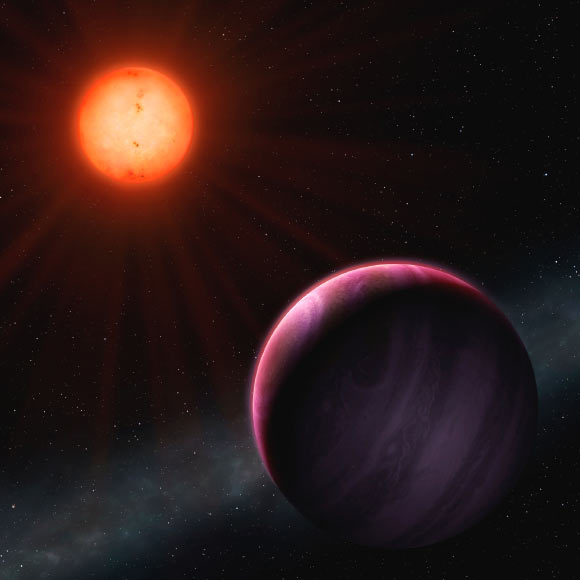Dr. Daniel Bayliss, an astronomer at the University of Warwick, and colleagues has discovered a giant gaseous planet orbiting a small M-dwarf star 600 light-years from Earth.

Artist’s impression of the cool red star NGTS-1 and the hot-Jupiter NGTS-1b against the Milky Way. Image credit: Mark Garlick / University of Warwick.
NGTS-1b — due to its size (20% less massive than Jupiter but 33% wider) and temperature (800 Kelvin, or 530 degrees Celsius) — is a so-called ‘hot Jupiter,’ a class of exoplanets that are at least as large as Jupiter.
Unlike Jupiter however, this planet is very close to its host star — just 3% of the distance between Earth and the Sun. It completes an orbit every 2.6 days, meaning a year on NGTS-1b lasts just 2.5 Earth-days.
In contrast, the parent star is small, with a radius and mass half that of our Sun.
According to Dr. Bayliss and co-authors, NGTS-1b’s existence challenges theories of planet formation which state that a planet of this size could not be formed around such a small star
“Despite being a monster of a planet, NGTS-1b was difficult to find because its parent star is so small and faint,” said co-author Professor Peter Wheatley, also from the University of Warwick.
“Small stars like this red M-dwarf are actually the most common in the Universe, so it is possible that there are many of these giant planets waiting to found.”
NGTS-1b is the first planet to be spotted by the Next-Generation Transit Survey (NGTS) at ESO’s Paranal Observatory in Chile.
“The discovery of NGTS-1b was a complete surprise to us — such massive planets were not thought to exist around such small stars — importantly, our challenge now is to find out how common these types of planets are in the Galaxy, and with the new NGTS facility we are well-placed to do just that,” Dr. Bayliss said.
“Having worked for almost a decade to develop the NGTS telescope array, it is thrilling to see it picking out new and unexpected types of planets,” Professor Wheatley said.
“I’m looking forward to seeing what other kinds of exciting new planets we can turn up.”
A paper describing the discovery will appear in the Monthly Notices of the Royal Astronomical Society and is now available online at arXiv.org.
_____
Daniel Bayliss et al. 2017. NGTS-1b: A hot Jupiter transiting an M-dwarf. MNRAS, in press; arXiv: 1710.11099







